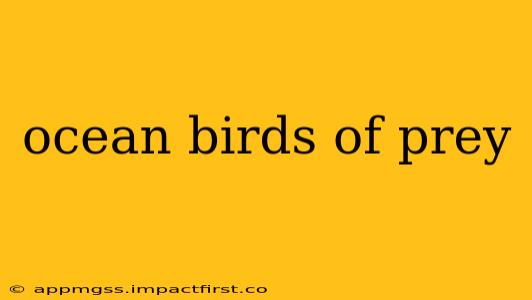The vast expanse of the ocean, a seemingly endless blue horizon, is home to a remarkable array of avian predators. These ocean birds of prey, masters of their aerial domain, showcase breathtaking hunting strategies and remarkable adaptations honed over millennia. From the icy Antarctic to the tropical waters of the equator, these formidable hunters play a crucial role in maintaining the delicate balance of marine ecosystems. This article delves into the fascinating world of these seafaring raptors, exploring their diverse species, hunting techniques, and the challenges they face in today's world.
What are the different types of ocean birds of prey?
While the term "bird of prey" typically conjures images of eagles and hawks, the ocean boasts a unique collection of avian hunters. Several bird families include species that could be considered ocean birds of prey, primarily specializing in fish and other marine life. These include:
- Sulids (Sulidae): This family includes boobies and gannets, known for their spectacular plunge-diving techniques. They can dive from significant heights, hitting the water at impressive speeds to catch fish.
- Pelecaniformes: This order includes pelicans, frigatebirds, and cormorants, each exhibiting distinct hunting methods. Pelicans use their massive pouches to scoop up fish, while frigatebirds are kleptoparasites, stealing food from other seabirds. Cormorants are adept underwater divers.
- Alcids (Alcidae): This family comprises auks, puffins, and murres, all masters of underwater pursuit. They use their wings for propulsion underwater, chasing fish and crustaceans.
- Laridae (Gulls & Terns): While not exclusively marine hunters, many gull and tern species heavily rely on marine life for sustenance, exhibiting opportunistic hunting behaviors.
What are the hunting techniques of ocean birds of prey?
The hunting methods employed by ocean birds of prey are as diverse as the species themselves. Some key strategies include:
- Plunge Diving: Boobies and gannets are renowned for their spectacular plunge dives. They spot prey from high altitudes and dive at incredible speeds, entering the water with minimal splash.
- Surface Seizing: Many gulls and terns snatch fish from the surface of the water, using their sharp beaks and agile movements.
- Underwater Pursuit: Alcids are specialized underwater hunters, utilizing their wings for propulsion to chase fish and crustaceans in the depths.
- Kleptoparasitism: Frigatebirds are notorious for stealing food from other seabirds, a hunting strategy that requires aerial agility and cunning.
What are the main threats to ocean birds of prey?
These magnificent birds face a multitude of threats in the modern world:
- Overfishing: Depletion of fish stocks directly impacts the food sources available to these predators.
- Habitat Loss: Coastal development and pollution destroy critical breeding and foraging habitats.
- Climate Change: Rising sea levels, changing ocean currents, and altered weather patterns disrupt their delicate ecosystems.
- Plastic Pollution: Ingestion of plastic debris can cause serious harm or even death.
What is the conservation status of ocean birds of prey?
The conservation status varies greatly depending on the specific species. Some species are thriving, while others are facing significant population declines and are listed as vulnerable, endangered, or critically endangered. Conservation efforts are crucial to protect these vital components of marine ecosystems. These efforts often include:
- Marine Protected Areas: Establishing protected areas helps safeguard critical habitats and breeding grounds.
- Sustainable Fishing Practices: Promoting sustainable fisheries helps ensure adequate food sources for these predators.
- Reducing Plastic Pollution: Addressing plastic pollution is critical to mitigating the threat to ocean birds.
- Research and Monitoring: Continued research and monitoring of populations help assess the effectiveness of conservation efforts and inform future strategies.
How can I help protect ocean birds of prey?
Even individuals can contribute to the conservation of these incredible birds. Consider these actions:
- Support sustainable seafood choices.
- Reduce your plastic consumption.
- Advocate for marine protected areas.
- Support organizations dedicated to bird conservation.
- Educate others about the importance of these birds and the threats they face.
By understanding the challenges faced by ocean birds of prey and actively participating in conservation efforts, we can help ensure the survival of these magnificent creatures for generations to come. Their continued presence is a testament to the health and vitality of our oceans.
